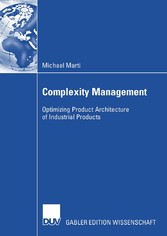Search and Find
Service
1 Introduction (S. 1)
If one does not begin with a right attitude, there is little hope for a right ending.
Kung Fu meditation.
1.1 Problem Statement
A successful product must satisfy customer requirements and preferences. As this bundle of market needs has many facets and is highly complex in its nature, it is called external complexity here. To comply with these diverse demands, companies design their product portfolios accordingly, i.e. they introduce variety to their products. This, in turn, increases not only the product’s complexity but affects the complexity within the entire company. This enterprise-internal complexity spreads to all functional areas (product development, logistics, production, and sales, to name a few) and is called internal complexity.
The products of an enterprise are exposed to external complexity and cause internal complexity. Therefore, products must be designed to cope with the implications of both external and internal complexity because they are a very important instrument for achieving sustained profits and assuring long-term survival. Complexity is not an evil per se, though. Both the benefit created by product variants and the costs they cause must be weighed against each other in order to find the optimum combination (Rathnow, 1993, pp. 1-4 and pp. 41-42).
The benefit side is explained by the purpose of product variety, which is to match the product with customers’ requirements as closely as possible and to acquire new customers, which increases sales, and retain existing ones. On the cost side, introducing product variants entails additional complexity costs that are effective initially (when the product is launched) as well as continuously over the product’s life cycle.
As the product variety benefits cannot be harvested without a rise in complexity costs, the goal is not to reduce product complexity as far as possible but to find the optimum level of complexity that takes into account the benefits as well as the costs generated by product variety. As the product portfolio grows and variants proliferate, complexity costs do not spread equally among all product variants (Schuh &, Schwenk, 2001, pp. 17-19). Due to a lack of economies of scale, low-sales variants generate more per unit costs than the high-sales variants, which are produced in larger numbers.
A problem of traditional cost accounting systems lies in their insufficient capability of transparently tracing back all costs to the respective variants. As a result, low-sales variants are priced too low, effectively being subsidized by the high-sales variants (Cooper &, Kaplan, 1988a). The product architecture inherently determines the nature of the complexity costs generated by all the variants of that product.
It is a very important element in defining the internal complexity necessary to respond to the external (market) complexity. Depending on how the architectures of its products are structured, an enterprise can take advantage of a high degree of commonality – which keeps costs low – while still maintaining a sufficiently high level of distinctiveness – what customers care about. Bearing in mind that complexity costs affect virtually all enterprise functions over the entire product life cycle, one can appreciate the importance of well-founded decisions concerning the product architecture.
All prices incl. VAT













